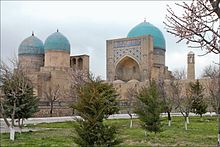Nautaca

Kok-Gumbaz mosque
|
|
| UNESCO World Heritage Site | |
|---|---|
| Location |
Qashqadaryo Region, Uzbekistan |
| Coordinates | 39°03′N 66°50′E / 39.05°N 66.83°E |
| Area | 240 ha (26,000,000 sq ft) |
| Criteria | Cultural: (iii), (iv) |
| Reference | 885 |
| Inscription | 2000 (24th Session) |
| Endangered | 2016– |
|
[]
|
|
Shakhrisabz (Uzbek: Шаҳрисабз Shahrisabz; Tajik: Шаҳрисабз; Persian: شهر سبز, translit. shahr-e sabz (city of green / verdant city); Russian: Шахрисабз), is a city in Qashqadaryo Region in southern Uzbekistan located approximately 80 km south of Samarkand with a population of 100,300 (2014). It is located at an altitude of 622 m. Historically known as Kesh or Kish, Shahrisabz was once a major city of Central Asia. It is primarily known today as the birthplace of 14th-century Turco-Mongol conqueror Timur.
Formerly known as Kesh or Kish (i.e., "heart-pleasing") and tentatively identified with the ancient Nautaca, Shahrisabz is one of Central Asia’s most ancient cities. It was founded more than 2,700 years ago and formed a part of the Achaemenid Empire or Persia from the 6th to 4th centuries BC. Throughout this period Kesh remained an important urban center of Sogdiana, a major province within the Empire. Documents from the late Achaemenid period speak of the renovation of the city's walls. Its name was officially changed to Shahrisabz in the modern era.
Alexander the Great's general Ptolemy captured the satrap of Bactria and pretender to the Persian throne, Bessus, at Nautaca thus ending the once great Achaemenid Empire. Alexander the Great chose to spend his winters and met his wife Roxanna in the area in 328-327 BC. Between 567 and 658 CE rulers of Kesh paid taxes to khagans of Turkic and Western Turkic khaganates. In 710 the city was conquered by the Arabs and following the Mongol Invasion in the 13th century, the region came under the control of the Barlas tribe, all of whose lineages seem to have been associated with this region. Kesh was the birthplace of Timur in 1336, to the family of a minor local Barlas chief, and during the early years of the Timurid Dynasty, the city enjoyed his considerable patronage. Timur regarded Kesh as his “home town” and planned it eventually to be the location of his tomb. However, during his reign, the center of activity shifted to Samarkand instead. According to legend, the Khan of Bukhara, Abdullah Khan II had the city destroyed in a fit of rage over the death of his favorite horse from exhaustion on a steep approach to the city, but was later overcome with remorse for the damage he had done.
...
Wikipedia

